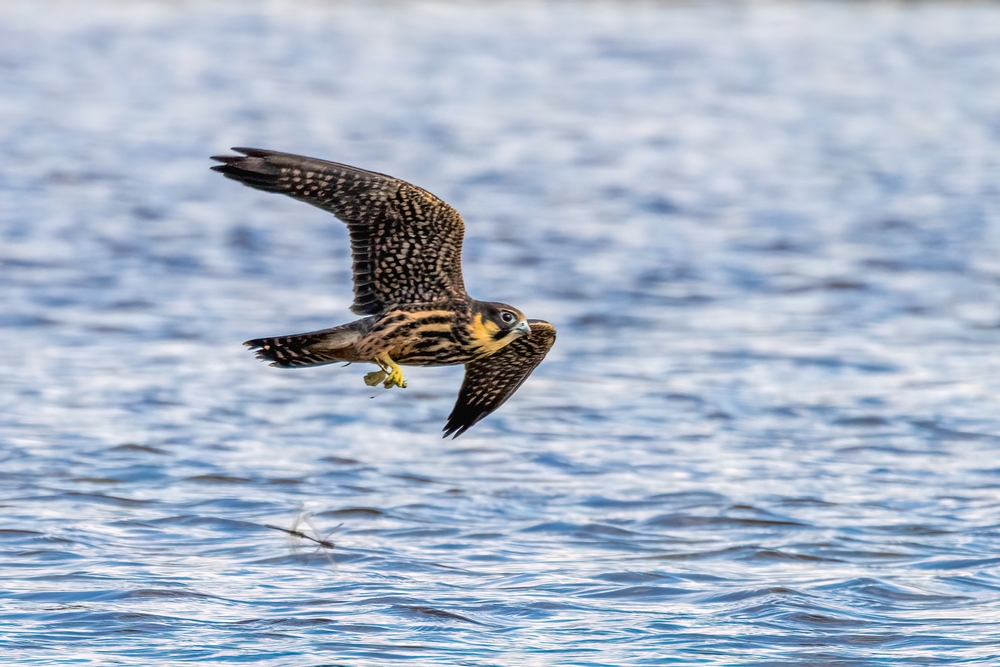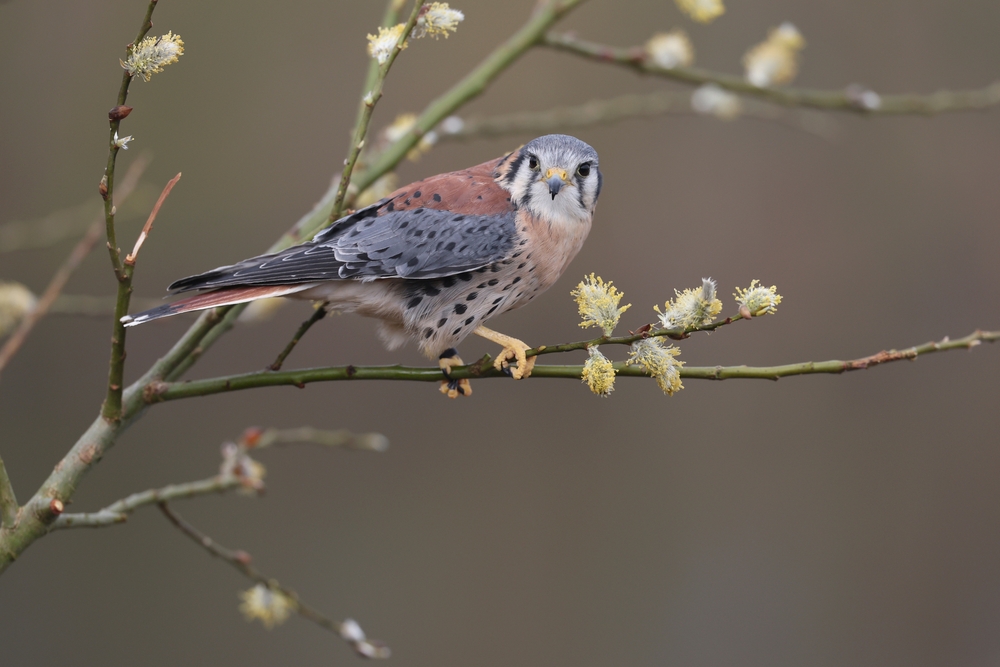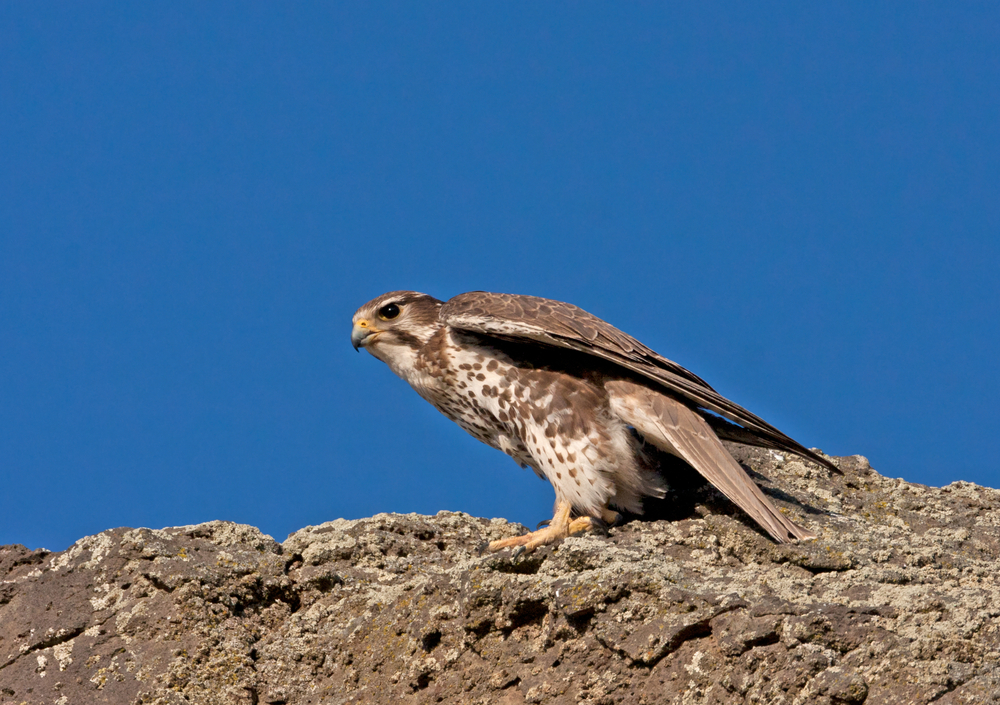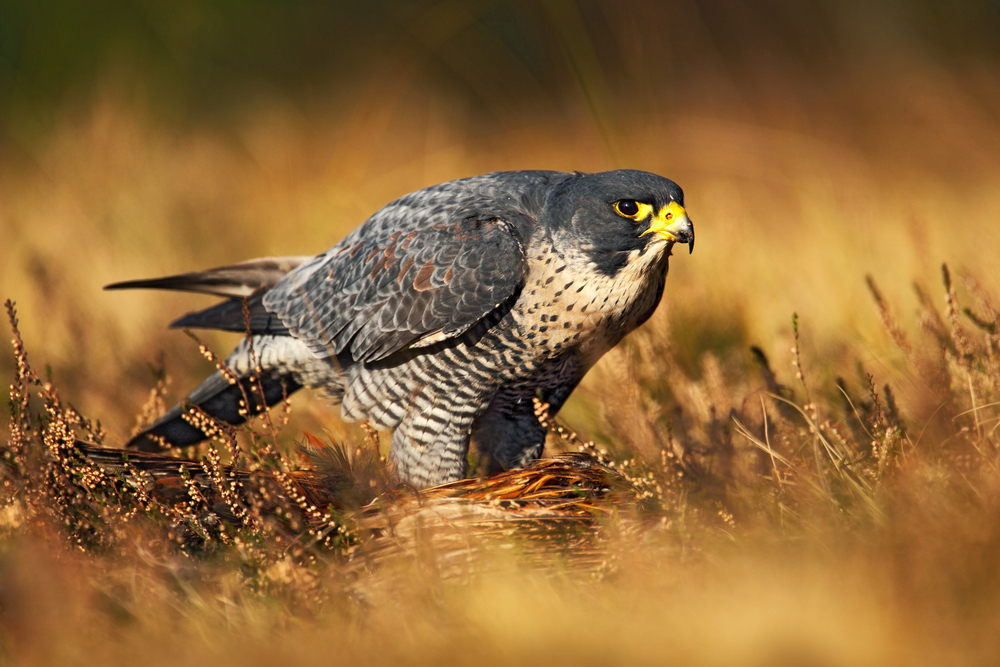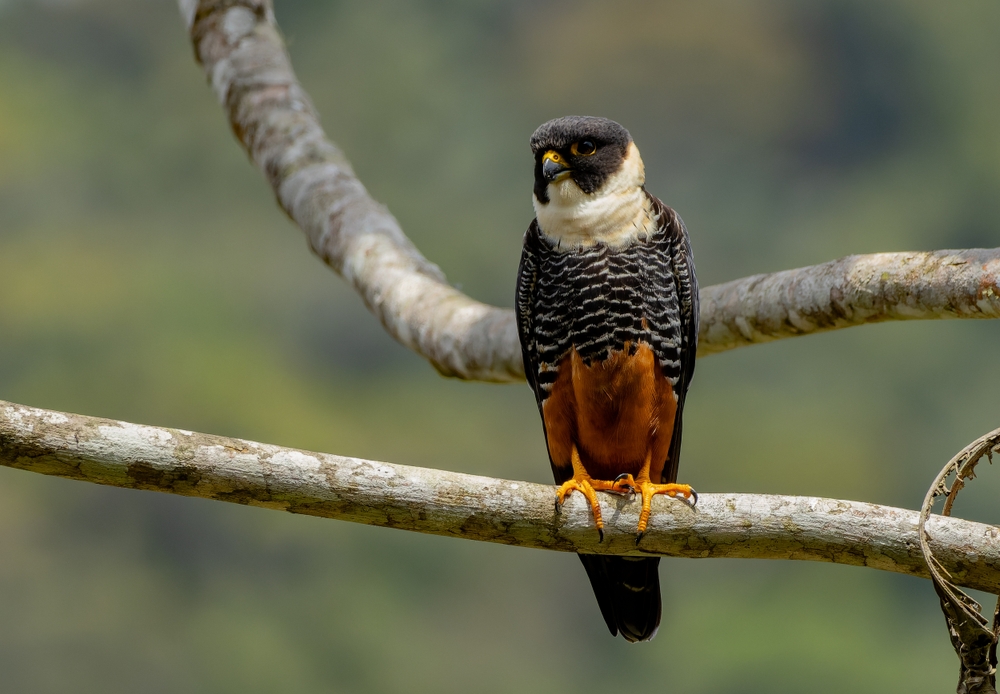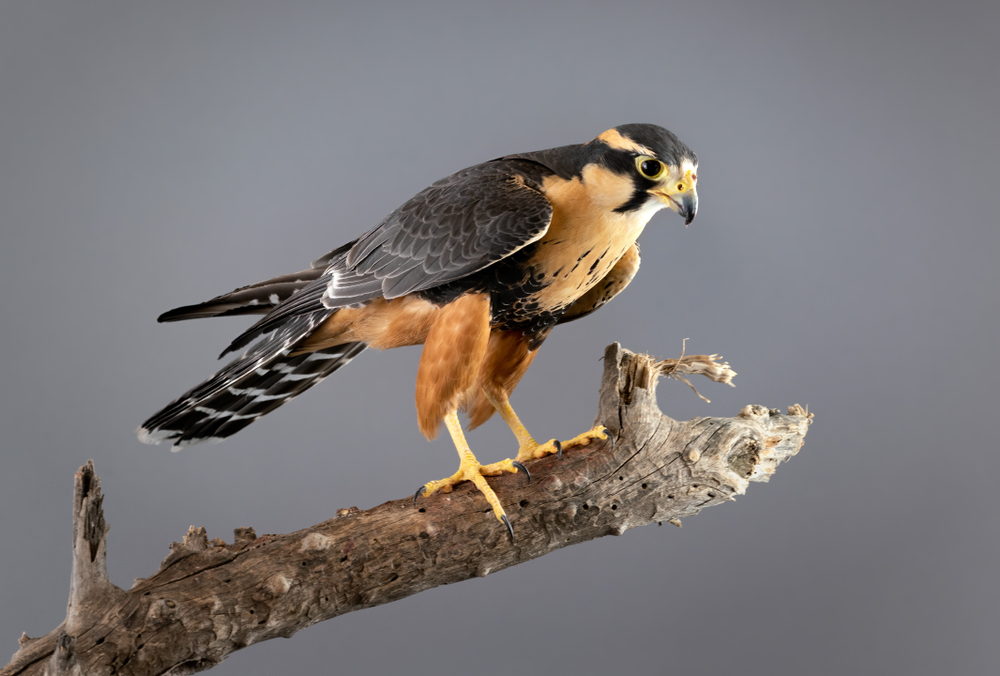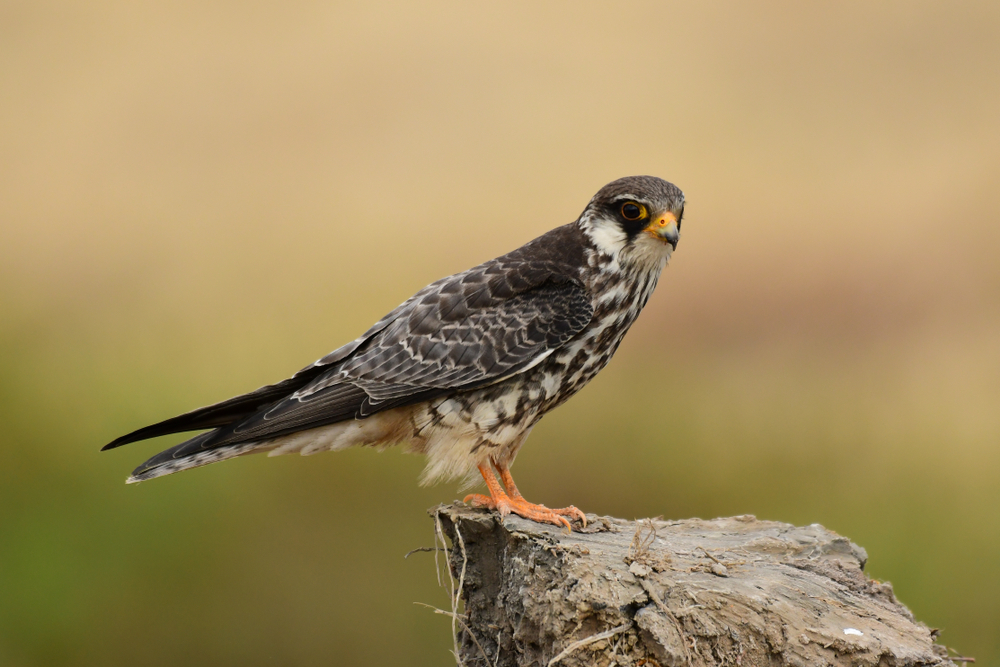The Eurasian Hobby (Falco subbuteo) is most closely related to the African Hobby (Falco cuvierii) and the Oriental Hobby (Falco severus), both sharing similar size, plumage, and hunting behavior.
About
The Eurasian Hobby (Falco subbuteo) is a small, slender falcon of the Falconidae family, renowned for its speed and agility in the air. Found across Europe, Asia, and parts of Africa, it favors open woodlands, wetlands, and grasslands, often hunting along forest edges and over open skies. Its swift, acrobatic flight and striking appearance make it one of the most admired falcons in its range.
Measuring 29 to 36 centimeters (11 to 14 inches) in length with a wingspan of 74 to 84 centimeters (29 to 33 inches), the Eurasian Hobby is built for speed. It has long, pointed wings and a narrow body, resembling a small Peregrine Falcon. Adults show slate-gray upperparts, a dark crown, a bold mustache stripe, and pale underparts streaked with dark lines. Their rufous-red “trousers” on the thighs and under-tail coverts are distinctive field marks.
The Eurasian Hobby primarily preys on dragonflies, beetles, and other large insects, which it snatches with talons mid-flight and eats on the wing. It also hunts small birds, such as swallows and swifts, often chasing them in dramatic aerial pursuits. Its hunting prowess and ability to turn sharply in the air make it a master of aerial combat.
Breeding occurs across Europe and Asia, where the Hobby uses old nests built by crows or other birds in tall trees. Females usually lay two to four eggs, with both parents sharing feeding duties. In Africa, where many Eurasian Hobbies winter, they are often seen in loose flocks feeding on insects.
The species is currently listed as Least Concern, with stable populations, though localized declines occur due to habitat loss and pesticide use that reduces insect prey.
Graceful, swift, and elegant, the Eurasian Hobby embodies the speed and finesse of falcons, excelling as one of nature’s most skillful aerial hunters.
Physical Characteristics
The Eurasian Hobby (Falco subbuteo) is a slender, medium-sized falcon admired for its speed, streamlined shape, and graceful flight.
Plumage:
-
Adults: Dark slate-gray upperparts, contrasting with pale underparts streaked with dark vertical lines. The throat and cheeks are white, and the under-tail coverts and “trousers” are rich rufous, giving the appearance of reddish leggings.
-
Juveniles: Browner overall, with heavier streaking on the breast and paler rufous tones on the thighs and under-tail coverts.
Head and Face:
The head is sleek and dark, featuring a bold black “moustache” stripe beneath the eye, contrasted by a pale cheek and throat. Large, dark eyes provide excellent vision for high-speed hunting.
Body and Wings:
The body is slender and streamlined, with long, narrow, and pointed wings resembling those of a swift. This design allows it to achieve remarkable speed and maneuverability in aerial pursuits.
Tail:
The tail is long, narrow, and slightly rounded at the tip, often showing subtle gray banding. It plays an important role in balancing and steering during flight.
Size:
-
Length: 11–13 in (29–34 cm)
-
Wingspan: 29–33 in (74–84 cm)
-
Height at Rest: About 12 in (30 cm) when perched
Weight:
-
Adult Male: 5.6–7.4 oz (160–210 g)
-
Adult Female: 6.7–10.6 oz (190–300 g)
The Eurasian Hobby’s sleek form, pointed wings, and rufous “trousers” make it one of the most easily recognized small falcons. Its build is perfectly adapted for catching birds and insects in agile, high-speed flight.
Reproduction
The Eurasian Hobby (Falco subbuteo) breeds during the summer months across Europe and Asia, timing its nesting season with the peak abundance of insect and bird prey.
1. Mating and Courtship:
Eurasian Hobbies are generally monogamous during the breeding season. Courtship involves aerial chases, food passes in mid-air, and high-pitched calls. The male often provides prey to the female as part of pair-bonding.
2. Nesting Sites:
They do not build their own nests. Instead, they use abandoned nests of crows, magpies, or other large birds, usually high in trees along woodland edges, river valleys, or open plains.
3. Egg Laying:
The female lays 2–4 eggs per clutch, usually in June or July. Eggs are creamy-white with reddish-brown blotches.
4. Incubation:
The incubation period lasts about 28–31 days. The female performs most of the incubation, while the male hunts and provides food.
5. Hatching and Care of Chicks:
Chicks hatch with white down and are completely dependent on parental care. The female broods the young during the first two weeks, while the male supplies prey. As the chicks grow, both parents share feeding duties.
6. Fledging and Independence:
Nestlings fledge at about 28–30 days old, taking their first flights in late July or August. After fledging, juveniles remain with their parents for another 2–4 weeks, learning hunting skills before migrating south.
7. Breeding Frequency:
Eurasian Hobbies raise one brood per year, timed to ensure that chicks are strong enough to migrate in autumn.
The Eurasian Hobby’s reproductive strategy of using old nests, moderate clutch sizes, and strong parental cooperation helps ensure chick survival despite the demands of long-distance migration.
Lifespan
The lifespan of the Eurasian Hobby (Falco subbuteo) reflects both the challenges of migration and the advantages of adaptability in varied habitats across its wide range.
Lifespan in the Wild:
Eurasian Hobbies typically live 8–10 years in the wild, though many juveniles do not survive their first year due to predation, weather, or food shortages. The oldest known wild individuals have lived up to 14 years.
Lifespan in Captivity:
In captivity, with consistent care and protection from natural hazards, Eurasian Hobbies may live 15–18 years, though records beyond this are rare.
Threats to the Eurasian Hobby:
-
Predation: Eggs and chicks are vulnerable to crows, owls, and martens. Adults may fall prey to larger raptors such as goshawks.
-
Habitat Loss: Removal of woodlands, hedgerows, and wetlands reduces nesting and feeding grounds.
-
Climate Change: Shifts in weather patterns may affect the timing of insect and bird migrations, creating mismatches with breeding needs.
-
Human Pressures: Disturbance near nest sites, agricultural expansion, and pesticide use reducing insect prey threaten populations.
Conservation efforts that protect woodlands, wetlands, and migratory corridors are essential to maintaining healthy populations of this agile falcon.
Eating Habits
The Eurasian Hobby (Falco subbuteo) is a swift, aerial hunter that relies heavily on agility and speed to capture prey in open skies.
Diet:
-
Birds: Small birds, particularly swifts, swallows, martins, and sparrows, are a major food source.
-
Insects: Large flying insects, including dragonflies, beetles, and moths, are especially important during summer.
-
Occasional Prey: May also take bats and small mammals when available.
Hunting Strategy:
-
Aerial Pursuit: The Eurasian Hobby is renowned for its speed and acrobatics, often chasing swallows and swifts in fast, twisting pursuits.
-
Insect Capture: It catches dragonflies and other insects in mid-air, often transferring them to its beak with its talons while flying.
-
Crepuscular Activity: Particularly active during dawn and dusk, when insect and bird activity peaks.
Feeding Behavior:
-
Small prey like insects are frequently eaten on the wing.
-
Larger prey, such as birds, are usually carried to a perch where they are plucked and consumed.
-
During breeding, males capture and deliver food to females and chicks, often making mid-air prey transfers.
Success and Adaptability:
Its ability to switch between birds and insects allows the Eurasian Hobby to thrive across a wide range of habitats, from European farmlands and wetlands to Asian grasslands and forests. Its resemblance to swifts in flight makes it one of the most graceful falcons to observe.
Uniqueness
The Eurasian Hobby (Falco subbuteo) is a sleek and agile falcon with distinctive traits that set it apart from many other raptors.
Swift-like Flight:
The Eurasian Hobby is often compared to swifts, with which it shares similar pointed wings and acrobatic flight style. It can match swifts and swallows in aerial pursuits—an ability rare among raptors.
Specialized Insect Hunter:
While many falcons focus primarily on birds, the Hobby is highly adept at catching large flying insects, such as dragonflies and beetles, and eating them mid-air.
Elegant Appearance:
Its striking combination of slate-gray upperparts, white throat, and rufous “trousers” makes it one of the most visually distinctive falcons.
Long-Distance Migrant:
The Eurasian Hobby undertakes impressive migrations, breeding across Europe and Asia before traveling to Africa and South Asia for the winter, covering thousands of miles annually.
Mid-Air Food Transfers:
Pairs often exchange prey in flight, especially during courtship and chick feeding. This behavior demonstrates both their agility and strong pair bonds.
Adaptability to Varied Habitats:
From European wetlands to Asian steppes, the Eurasian Hobby thrives in diverse ecosystems, provided open skies and abundant insect and bird prey are available.
The Eurasian Hobby’s combination of swift-like flight, insect-catching prowess, and long-distance migration makes it one of the most graceful and fascinating small falcons of the Old World.
Be the First to Share Photos of This Species.
FAQ’s
1. What is the species closest to the Eurasian Hobby?
2. How does the Eurasian Hobby compare to other falcons?
The Eurasian Hobby is slimmer and more swift-like than most falcons. While Peregrines rely on high-speed stoops, Hobbies excel in fast, acrobatic aerial pursuits, often catching insects and swallows mid-flight.
3. Which national parks provide the best opportunities to see a Eurasian Hobby?
Which national parks provide the best opportunities to see a Eurasian Hobby?
-
Kruger National Park (South Africa): A prime wintering area where Hobbies hunt insects at dusk.
-
Kaziranga National Park (India): Migratory stopover for Hobbies en route from Asia.
-
Doñana National Park (Spain): A key breeding and migration site in Europe.
-
Biebrza National Park (Poland): Wetland breeding grounds that attract Hobbies in summer.



































































